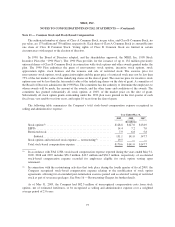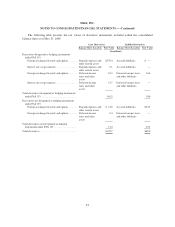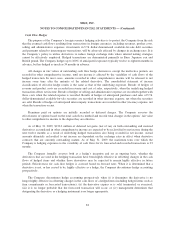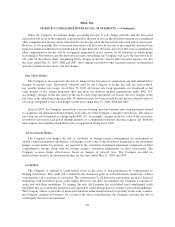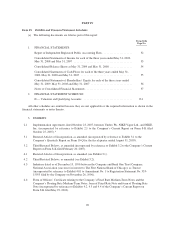Nike 2009 Annual Report Download - page 82
Download and view the complete annual report
Please find page 82 of the 2009 Nike annual report below. You can navigate through the pages in the report by either clicking on the pages listed below, or by using the keyword search tool below to find specific information within the annual report.NIKE, INC.
NOTES TO CONSOLIDATED FINANCIAL STATEMENTS — (Continued)
On April 17, 2008, the Company completed the sale of NIKE Bauer Hockey for $189.2 million in cash to a
group of private investors (“the Buyer”). The sale resulted in a net gain of $32.0 million recorded in the fourth
quarter of the year ended May 31, 2008. This gain included the recognition of a $46.3 million cumulative foreign
currency translation adjustment previously included in accumulated other comprehensive income. As part of the
terms of the sale agreement, the Company granted the Buyer a royalty free limited license for the use of certain
NIKE trademarks for a transitional period of approximately two years. The Company deferred $41.0 million of
the sale proceeds related to this license agreement, to be recognized over the license period.
The gains resulting from these divestitures are reflected in other (income) expense, net and in the corporate
expense line in the segment presentation of pre-tax income in Note 19 — Operating Segments and Related
Information.
Note 18 — Risk Management and Derivatives
The Company is exposed to global market risks, including the effect of changes in foreign currency
exchange rates and interest rates, and uses derivatives to manage financial exposures that occur in the normal
course of business. The Company does not hold or issue derivatives for trading purposes.
The Company formally documents all relationships between hedging instruments and hedged items, as well
as its risk management objective and strategy for undertaking hedge transactions. This process includes linking
all derivatives to either specific firm commitments, forecasted transactions or net investments. The Company also
enters into foreign exchange forwards to mitigate the change in fair value of specific assets and liabilities on the
balance sheet; these are not designated as hedging instruments under FAS 133. Accordingly, changes in the fair
value of hedges of recorded balance sheet positions are recognized immediately in other (income) expense, net,
on the income statement together with the transaction gain or loss from the hedged balance sheet position.
Substantially all derivatives outstanding as of May 31, 2009 are designated as either cash flow, fair value or
net investment hedges. All derivatives are recognized on the balance sheet at their fair value and classified based
on the instrument’s maturity date. The total notional amount of outstanding derivatives as of May 31, 2009 was
$7.1 billion, which is primarily comprised of cash flow hedges denominated in Euro, Japanese yen and British
pound.
80







